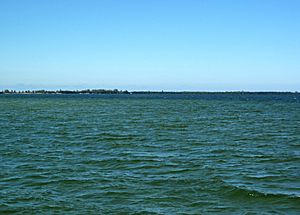Pine Island Sound facts for kids
Pine Island Sound is a large, shallow body of water in Lee County, Florida. It lies between Pine Island and several barrier islands. These islands include Sanibel Island, Captiva Island, North Captiva Island, and Cayo Costa. They help separate the Sound from the Gulf of Mexico.
Pine Island Sound connects to other important waterways. To the north, it links with Gasparilla Sound and Charlotte Harbor. To the south, it joins San Carlos Bay and the Caloosahatchee River.
The Sound is part of the Pine Island Sound Aquatic Preserve. This protected area was created in 1970. It covers about 190 square kilometers (54,000 acres) of underwater land.
Contents
Amazing Habitats of Pine Island Sound
Pine Island Sound is home to many important natural areas. These habitats provide food and shelter for countless animals.
- Mangroves: These special trees grow in salty water. Their tangled roots offer safe places for young fish and crabs.
- Seagrass Beds: Underwater meadows of seagrass are vital. They are a main food source for manatees and sea turtles.
- Salt Marshes: These grassy wetlands are flooded by tides. They act as nurseries for many marine creatures.
- Oyster Communities: Groups of oysters form reefs. These reefs help filter the water, keeping it clean.
- Tidal Flats: These muddy or sandy areas are exposed at low tide. They are feeding grounds for many birds.
- Sponge Beds: Sponges attach to the seafloor. They filter water and provide homes for small organisms.
Red Tide and Its Effects
Sometimes, tiny living things called dinoflagellates grow very quickly in the water. This is known as a red tide. The specific type found here is Karenia brevis.
Red tides can affect all animals in Pine Island Sound. This includes mollusks, fish, birds, and even mammals. Scientists study red tides to understand how they impact the environment.
Boating and Water Safety
Pine Island Sound is quite shallow in many places. Because of this, boaters need to be careful. It is important to use up-to-date maps and tide tables. This helps boats avoid getting stuck or damaging the sensitive seafloor.
A Look Back: History of Pine Island Sound
For thousands of years, people have lived around Pine Island Sound. The Calusa Indians and their ancestors called this area home.
Ancient Calusa Sites
- Pineland Archeological District: This 67-acre site is on the western shore of Pine Island. It features several large shell mounds. These mounds were built by the Calusa. One mound was used for burials.
- Mark Pardo Shellworks Site: This site is located on Cayo Costa Island. It shows how the Calusa used shells.
- Useppa Island: In the northern part of the Sound, Useppa Island has a long history. Archaeologists have found many signs of ancient life there.
Fishing Camps and Early Settlers
In the 1700s and 1800s, Cuban fishermen used Pine Island Sound. They set up seasonal camps to catch fish. These fish were then sent to markets in Havana, Cuba.
Exploring the Great Calusa Blueway
Today, Pine Island Sound is a popular spot for outdoor activities. It is a main part of the Great Calusa Blueway. This is a long trail for canoes and kayaks. The Blueway stretches for 190 miles, offering amazing paddling adventures.


